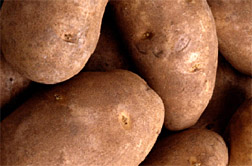This page has been archived and is being provided for reference purposes only. The page is no longer being updated, and therefore, links on the page may be invalid.
|
|
|
|
Tough New Spuds Take on Double Trouble
By Jan SuszkiwMarch 2, 2010
Americans love potatoes, consuming about 130 pounds per person annually. But it's a wonder the spuds even make it to the dinner table, given the many fungal diseases that attack the tuber crop—powdery scab and black dot among them.
Now, five new potato breeding lines being tested by Agricultural Research Service (ARS) scientists and collaborators could open the door to new varieties of the crop that resist powdery scab and black dot diseases, caused by the fungi Spongospora subterranea and Colletotrichum coccodes, respectively.
These fungi often occur together in the same soil, attacking the potato plant's roots, tubers or stems. Outbreaks can cause yield losses of up to 25 percent and prevent tubers from reaching the sizes needed by the french fry and fast-food industry. Of the two fungi, only black dot can be chemically controlled with fungicides; however, multiple applications are needed, ratcheting up production costs to prohibitive levels. A more sustainable alternative is genetic resistance, according to geneticist Chuck Brown, with the ARS Vegetable and Forage Crops Production Research Laboratory in Prosser, Wash.
In studies conducted there since 2004 with Washington State University professor Dennis Johnson, assistant Tom F. Cummings and postdoctoral associate Nadav Nitzan, Brown screened an existing collection of wild and cultivated potatoes for sources of natural resistance to powdery scab and black dot in a local grower's infested field.
The effort ultimately led to five advanced potato breeding lines that had been developed from a wild species from Mexico, Solanum hougasii, and a recent commercial release, Summit Russet. In three years of field trials in Washington State and Idaho, the potato breeding lines consistently showed fewer disease symptoms—root galling for powdery scab and sclerotia-infected stems for black dot—than other lines and varieties tested.
The potato breeding lines themselves aren't intended for production. Instead, they'll be made available as seed for use in breeding programs aimed at developing the first commercial varieties with dual resistance to the fungal diseases, according to Brown, who discussed the research at the 48th Annual Washington State Potato Conference in January.
The research findings have been published in the journal Plant Disease.
ARS is the principal intramural scientific research agency of the U.S. Department of Agriculture (USDA). This research supports the USDA priority of promoting international food security.

